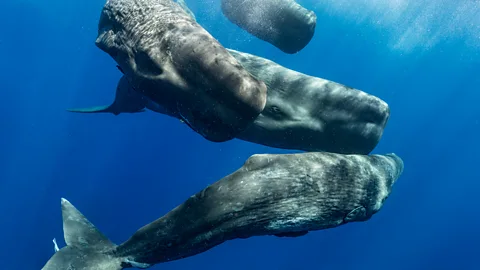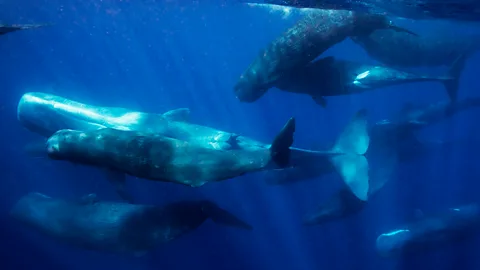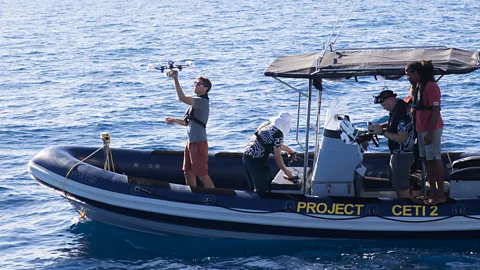By Catherine Latham and Anna Bressanin,
 Amanda Cotton/CETI Project
Amanda Cotton/CETI ProjectScientists studying sperm whale communication say they have discovered complex structures similar to human language.
 Amanda Cotton/CETI Project
Amanda Cotton/CETI Project“At a depth of 1,000 m (3,300 ft), most of the group is flanking each other, but looking in the same direction over an area of several kilometers,” says Young. “During this time they are talking and pressing all the time.” After about an hour, he says, the group will rise to the surface in sync. “They have a resting phase. They can be on the surface for 15-20 minutes. Then they dive back into the water,” he says.
At the end of a foraging day, Young says, sperm whales congregate on the surface, rub against each other, chat and socialize. “As researchers, we don’t see much of their behavior because they don’t spend a lot of time on the ground,” he says. “There are masses of them that we don’t know about because we’re only seeing a tiny snapshot of their life on Earth in 15 minutes.”
About 47 million years ago, terrestrial cetaceans began to appear pulling back towards the ocean – this is 47 million years of evolution in an environment alien to our own. How can we easily understand creatures that have adapted to live and communicate under such diverse evolutionary pressures?
“Parts where our world and theirs overlap are easy to translate — like feeding, breastfeeding, or sleeping,” says David Gruber, CEO and founder. Cetacean Translation Initiative (Ceti) and Professor of Biology at the City University of New York. “As mammals, we share these fundamentals with others. But I think it’s really interesting when we try to understand where their world intersects with ours,” he says.
 CETI project
CETI projectSperm whales live multi-level, matrilineal societies – groups of girls, mothers and grandmothers – while males travel the oceans in groups to reproduce. They are known for their complex social behavior and group decision making, which requires complex communication. For example, they can adapt their behavior as a group to protect themselves from predators such as orcas to eat people.
Sperm whales communicate with each other a rhythmic sequence of clicks, called codas. Until now, it was thought that sperm had only 21 coda types. However, after examining nearly 9,000 records, Ceti researchers identified 156 distinct codas. They also observed the basic building blocks of these codes, which they described as the “sperm whale phonetic alphabet” — like phonemes, the units of sound in human language that combine to form words. (Watch the video below to hear some of the types of sperm sounds the AI has detected.)
Pratyusha Sharma, a postdoctoral fellow at MIT and lead author of the study, describes the “fine-grained changes” in the sounds the AI detects. Each code consists of three to 40 rapid-fire clicks. Sperm whales have been found to change the overall speed or ‘tempo’ of their codas, speeding up and slowing down during coda delivery, in other words making it ‘rubato’. Sometimes they added an extra click at the end of the coda, says Sharma, an “ornamentation” in the music. These subtle variations, he says, suggest sperm whale sounds can carry a much richer amount of information than previously thought.
“Some of these features are contextual,” says Sharma. “For example, in human language I can say ‘what’ or ‘aaaaaat!?’ It’s the same word, but you have to hear the whole sound to understand the meaning,” he says.
The researchers also discovered that sperm “phonemes” can be used in a combinatorial way, allowing whales to produce a wide repertoire of unique sounds. The existence of a combinatorial coding system, write the authors of the report, “duality of formation“- a linguistic phenomenon considered to be unique to human language – in which meaningless elements combine to form meaningful words.
 CETI project
CETI projectHowever, as Sharma points out, they have no proof of this yet. “What we’ve shown in sperm is that the codas themselves arise from a combination of these basic features. The codas are then put together sequence by sequence to form coda sequences.” Just like humans, they combine phonemes to form words and then words into sentences.
So what does all this tell us about the mind of sperm whales? Or their ability to think, or store and share information?
“Well, he hasn’t told us anything,” Gruber says. “Before we can get to these amazing questions, we need a basic understanding of how [sperm whales communicate] and what is important to them. We see them living very complex lives, coordination and complexity in their behavior. We are at base camp. This is a new place for people – give us a few years. Artificial intelligence will allow us to see the connection between whales in a deeper way than ever before.”
But as experts warn, not everyone is convinced an anthropocentric focus on language it risks forcing us to look from one perspective.
Young, though, describes the study as “one more step” toward understanding these giants of the deep. “We’re starting to put the pieces of the puzzle together,” he says. And maybe if we can listen and really understand something How important are sperm whale grandmothers to them – something that resonates with people, he says, and we can change human behavior to protect them.
category “vulnerableAccording to the International Union for Conservation of Nature (IUCN), sperm whales are recovering from commercial hunting by humans in the 19th and 20th centuries. And although hunting of such whales has been banned for decades, sperm whales face new threats, e.g. climate change, ocean noise and ship strikes.
But, Yang adds, we’re still a long way from understanding what sperm are saying to each other. “We really have no idea. But the better we understand these amazing animals, the more we’ll know how to protect them.”
—
If you like this story, Sign up for The Essential List newsletter – a curated selection of features, videos and unmissable news delivered to your inbox twice a week.
Follow us for more science, technology, environment and health news from the BBC Facebook and the X.
#Sperm #whale #phonetic #alphabet #discovered
